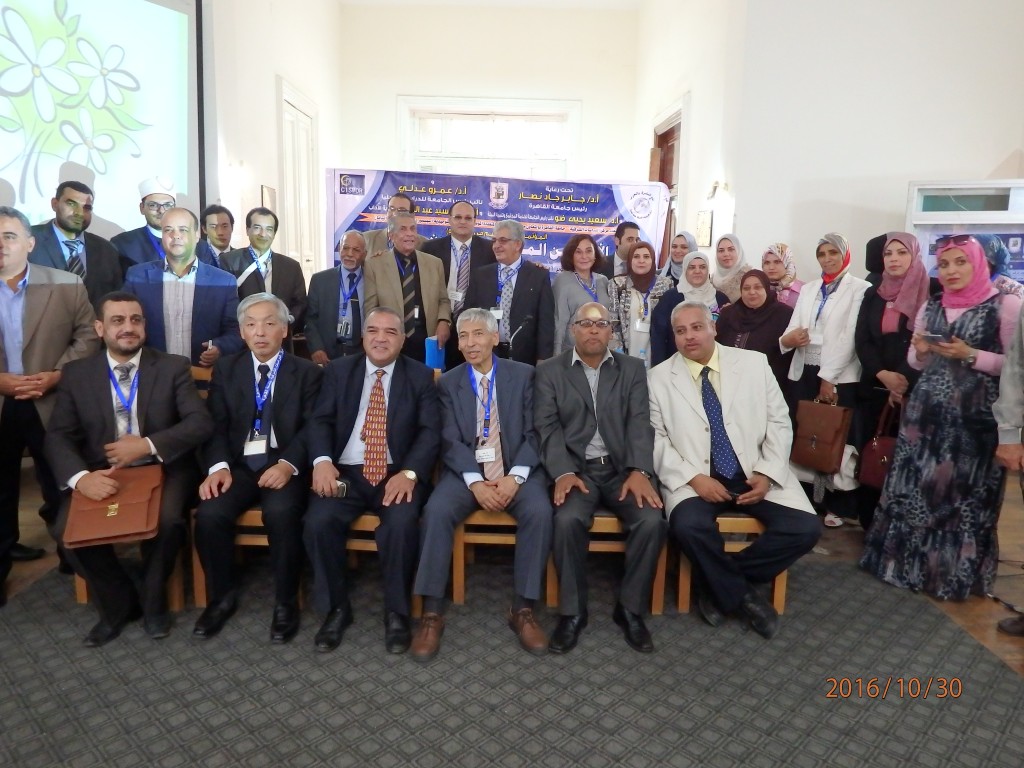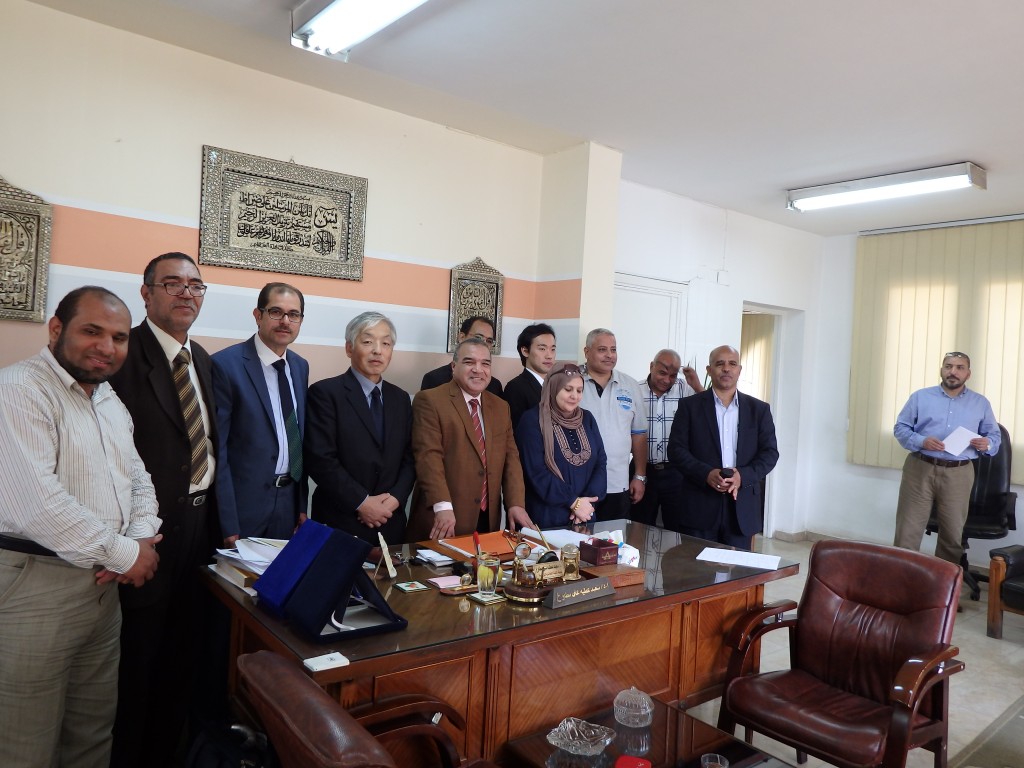Center for Interdisciplinary Study of Monotheistic Religions(CISMOR)Doshisha University
> Public Lectures > The 5th International Conference on Values in ReligionPublic Lectures
The 5th International Conference on Values in Religion
| Date: |
2016/10/30 10:00-18:00 2016/10/31 10:00-18:00 |
|---|---|
| Place: | Center for Oriental Studies, Cairo University |
| Lecture: |
Junya Shinohe (Professor of Doshisha Unviersity / Director of CISMOR) Samir Nouh (Visiting Professor of Doshisha University) Hiroshi Tone (Ph.D. Program of Doshisha University) |
| Summary: | |
|
The 5th International Conference on Values in Religion took place October 30 and 31 at Cairo University’s Center of Oriental Studies. Registered conference attendees from Japan consisted of Professor Shinohe of Doshisha Theological Seminary, Professor Samir Nouh also of Doshishsa University, and Tone. Doshisha’s Center for Interdisciplinary Study of Monotheistic Religions (CISMOR) was a co-sponsor of the conference. The theme of the conference was “Holy Places in Religions and Creeds.” and what follows is a brief outline of discussion points. • Holy places in Judaism • Holy places in Christianity • Holy places in Islam • Holy places in non-monotheistic religions • Holy places in various eastern languages and literature • Conflict between religions regarding Holy places. • Changes regarding Holy places in local society The opening ceremony took place at 10 a.m. and Doshisha’s Center for Interdisciplinary Study of Monotheistic Religions was introduced by Professor Mohamed Hawary of Al-Azhar University. Together with Professor Samir, Professor Hawary confirmed the significance of collaborating with a Japanese research institute. The three Japanese representatives gave their talks immediately following the opening ceremony, with Professor Hawary serving as the moderator. Professor Samir gave the first talk, followed by Professor Shinohe and Tone. Professor Samir’s talk was entitled “The symbolism of Holy Places in Japanese Religious Thought: A Comparison with Islam.” Professor Shinohe’s talk was entitled “Japanese Holy Places: From a comparative Perspective with Islam.” Tone’s talk was entitled “On the Function of the Baptistery as Holy Place: Concerning Writings of Ambrose of Milan.” Regarding my talk, in accord with the conference theme, I considered holy places in Christianity and focused on the particular example of the baptistery. I explained how the origin of the baptistery’s architecture can be traced back to the Roman emperor’s Mausoleum and how the baptistery rituals relied on city water facilities. I also explained how Ambrose clarified the signification of baptism as the transition from degeneracy to purity. Lunch followed these presentations, with the international conference continuing after lunch and featuring an array of presentations until 7 p.m. There was much lively discussion. The Japanese participants attended every presentation and, in a break, gave an interview to Egyptian and Japanese (Asahi Newspaper) media for comments on the status of research into monotheistic religions in Japan. The following day (31st) was to be the second day of the conference; but as the presenters finished their sessions ahead of schedule, the Japanese delegation was shown around various holy sites in the environs of Cairo University. The first place the Japanese delegation visited was the Mohamed Ali Mosque. The mosque is located in citadel in the center of the UNESCO-registered historical district of Cairo. This citadel was built by Salah Ed-Din in 1176 in response to the invasions of the Christian Crusaders. The Mohamed Ali Mosque which is located in a corner of the citadel was built by command of Mohamed Ali who was sent by the Ottoman Empire. The Japanese delegation visited the mosque and got information about its architectural features. For example, we received narration of various notable artifacts such as the indentation in the wall facing Mecca ‘Mihrāb’ the king’s throne 'Minbar' located above stairs for the purpose of preaching. Along the way, there was a suddent pungent smell, so I asked Professor Salah Osman of Cairo University what it might be. He suggested it might be bird excrement. He explained that in the early days of Islam places of worship were not fixed, and so prayer carpets were placed in a corner of the current location. After a certain point, worship sanctuaries became located inside permanent structures, and so the carpets became more fixed and less easy to wash. Because the entrance door was left open, birds would come in and leave their mess. I came to appreciate the process of how a religion which began among desert dwellers eventually took root in urban centers and how certain aspects of the religion were difficult to adapt to changing environments. The next venue we toured was the diocese of the Coptic Christian Church. This area is said to have an ancient connection with the Bible. In Matthew’s gospel, (2:13-23), there is record of Mary escaping to Egypt with Jesus, and this dioceses is said to be the location where they stayed in Egypt. In fact, there is an subterranean cave under Church of St. Sergius in the diocese where Mary’s family took refuge and a torch continues to illumine the cave even today. For lack of time, it was not possible to tour the diocesian musuem, but we received a lecture on its features. Many artifacts relating to the history of the Coptic Church are preserved in the museum, and prominent among them is a collection of transcribed manuscripts, the well-known segment of the Nag Hammadi transcription and the oldest extant fragment of Psalms. At a later time, I was able to return to the museum and look at the transcripts, as well as important transcripts related to John of Damascus who took part in the debate about holy paintings and to Paul of Samosata who was condemned as a heretic in the 3rd century. After touring the Coptic diocese in Cairo, the international conference came to a close. In closing, I would like to articulate a topic of discussion we had with our Egyptian hosts. That topic was the significance of hosting an international research conference in Egypt. More specifically, we discussed the significance of how the monotheistic religions here in Egypt mutually influenced each other and how they coexisted without compromising their integrity. We were reminded how observing actual historical records and artifacts as opposed to merely reading about them, it is possible to get a more accurate and intimate sense for the religion practiced in daily life by the people of those times. We are then sure that our conference deserves this topic. I wish to express my deep appreciation to coordinators for their kindness, and I hope for more success of the international conference on values in religion. Translated by Stig Lindberg (Kyoto University) |
|
|
For more information, please contact; ■The Center of Oriental Studies, Cairo University: TEL: 37491531-33380247-33380427 FAX: 37491531 E-mail: oriental_studies_center■gmail.com P.O.B: 649-Orman-Post Code No: 12612 ■CISMOR, Doshisha University: TEL: 075-251-3726 FAX: 075-251-3092 E-mail: rc-issin■mail.doshisha.ac.jp ※Please retype ■ to @ |
|

